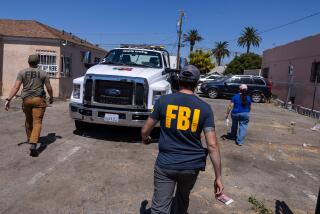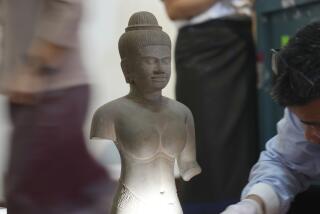Raids suggest a deeper network of looted art
Coordinated raids on four Southern California museums early Thursday suggest that the involvement of art institutions in the purchase of looted objects is far more extensive than recent high-profile scandals have indicated.
Even as the country’s most prominent museums were embarrassed by revelations of stolen artifacts in their collections, several local museums continued to pursue objects they had reason to believe were taken illegally from Thailand, Myanmar, China and Native American sites within the United States, according to search warrants served Thursday.
Dozens of federal agents descended on the Los Angeles County Museum of Art, Pasadena’s Pacific Asia Museum, the Bowers Museum in Santa Ana and Mingei International Museum in San Diego.
The raids marked the first public move in a five-year undercover investigation of the alleged smuggling pipeline.
Museum officials defended their practices and pledged to cooperate fully in the investigations.
The detailed warrants gave the agents broad authority to search the museums’ galleries, offices, storage areas and computer archives. They were looking for objects and records related to the primary targets of the investigation: an alleged art smuggler, Robert Olson, and the owner of a Los Angeles Asian art gallery, Jonathan Markell. Markell’s Silk Roads Gallery on La Brea Avenue was also raided.
No arrests were made, but legal experts say the surprise search warrants suggest prosecutors are collecting the final elements to seek criminal indictments against Markell and Olson.
The action comes after several years in which the art world has been hammered by claims from Italy and Greece that major American museums -- most prominently the J. Paul Getty Museum -- purchased art that had been stolen from and smuggled out of those countries.
The Getty agreed last year to return 40 of its most prized objects, following similar deals by museums in Boston and New York. The Getty’s former antiquities curator is on trial in Rome, accused of knowingly buying looted art, a charge she denies.
This case could go further. The warrants served Thursday show prosectors have carefully laid a foundation for the possible indictment of museum staffers allegedly complicit in the looting schemes -- which would be a first under American law, experts say.
The warrants are based on a five-year undercover investigation by an unnamed agent with the National Park Service, who presented himself to Olson and Markell as an eager collector.
Olson and Markell told the undercover investigator they regularly bought Thai antiquities from looters and smugglers, sometimes smuggling them personally, the warrants state. They then allegedly sold them to clients in Los Angeles. They also admitted running an elaborate donation scheme, selling their clients looted artifacts with forged appraisals that inflated the value of the objects by as much as 400%, the warrants state. They then allegedly helped these clients donate the objects to local museums, which provided a tax write off at the inflated value.
The scheme appears to have spanned the last decade and generally involved repeated donations of objects with values of just under $5,000, the value at which the IRS required additional documentation.
In the case of the Bowers and the Pacific Asia Museum, the warrants clearly suggest that officials were aware that the objects were looted and overvalued but accepted them anyway.
A senior curator at the Bowers Museum, now deceased, regularly accepted donations of Thai and Native American antiquities from Olson that he knew were removed illegally, the warrants say. The documents describe the longtime curator, Armand Labbe, smiling and chuckling as he told the agent he could accept the donations because “he could not determine” what rules the museum was supposed to follow.
The Bowers’ current director, Peter Keller, told the undercover agent he knew Olson and had visited his warehouse. An appraiser, described as Labbe’s girlfriend, told the agent that she regularly prepared appraisals of objects for Keller to donate to his own museum. Keller denied wrongdoing Thursday.
In the case of the Pacific Asia Museum in Pasadena, the agent met with two museum officials in in November 2005 and offered to donate Thai material he had purchased from Markell.
Marcia Page, the museum’s deputy director of collections, told the agent that given her position, she was “expected to at least put up token resistance to accepting antiquities without proper paperwork,” the warrant states. She noted that Markell had donated Thai material, and that she didn’t think it was legal. She said more senior people in the museum would have to sign the paperwork.
About two weeks later, Page told the agent that the bulk of his donation had been accepted.
LACMA, the Mingei and the UC Berkeley Art Museum all received similar donations from Markell or Olson over several years, the warrants say, but the documents are unclear about the extent to which museum officials knew of alleged theft or tax evasion.
According to the warrants, Markell at one point told the agent that LACMA was “a stickler” for checking the background of pieces. But the dealer also suggested the museum had pursued objects it knew were looted in the past.
“They knew,” Markell said of one artifact LACMA wanted that was taken out of Thailand after a law prohibiting exporting such items was passed there, according to the warrants. “Markell said that LACMA had found a loophole, but he was not clear on what that loophole was.”
The 150 pages of warrants filed Thursday paint a picture of rampant fraud and theft.
The charges that follow could include receiving stolen property, import violations and tax fraud. In particular, the warrants show that authorities are building a case that the looted antiquities should be considered stolen property under American law. Thailand has claimed state ownership of all artifacts since 1961, and American law would recognize that claim if certain conditions are met, said Marcia Isaacson, a former New York federal prosecutor who won a pivotal antiquities conviction several years ago.
The investigation targets art allegedly stolen from Thailand, China, Myanmar and Native American archeological sites that ended up in museums across the Southland.
The contested objects are far less valuable than those returned by the Getty but they are far more numerous, and some of the alleged conduct by museum officials, contained in hours of tape-recorded meetings, appears equally troubling.
Many come from the ancient civilization of the Ban Chiang, which occupied northeastern Thailand from 1000 BC to AD 200. “The original location where Ban Chiang culture was discovered was named a World Heritage Site in 1992 and is considered the most important prehistoric settlement yet discovered in Southeast Asia,” the warrants say.
The warrants allege that the Ban Chiang objects are probably looted because they were first excavated by archeologists in 1967, six years after Thailand banned the export of antiquities.
The Thai government never gave permission for the contested antiquities to leave the country. Moreover, importing such objects into the United States after 1979 was a violation of the U.S. National Stolen Property Act and the Archeological Resource Protection Act, the warrants state.
Other objects named in the warrants came from Burma (also known as Myanmar), from which the U.S. has banned imports since 2003, and China, which has strict export laws governing its antiquities. There are also objects allegedly stolen from Native American sites in the U.S., the sale of which are controlled by federal laws.
The investigation began in 2003, when the undercover agent with the National Park Service posed as a buyer and began purchasing looted art from Olson, according to the warrants. Olson, the warrants say, specializes in Native American and Thai anti- quities.
Olson allegedly told the agent he had been importing objects from Ban Chiang since the 1980s and had never received a permit from the Thai government. He said he got objects “as they were being dug up” and knew it was illegal to ship them out of the country, the warrants say.
The smuggled antiquities were affixed with “Made in Thailand” labels, and sometimes painted over, to make them look to U.S. customs officials like modern replicas, Olson allegedly told the agent.
Olson also claimed to have the largest collection of Native American ladles anywhere in the world and admitted that he had dug for artifacts on public land in New Mexico without authorization, the warrants state.
In September 2003, federal agents intercepted a shipment from Thailand destined for Olson and Markell. Markell and his wife own Silk Roads Gallery, which sells Asian and Buddhist art. Their website shows the couple in a photo with the Dalai Lama.
--
Times staff writers Ari Bloomekatz, Paloma Esquivel, Robert Lopez, David Reyes and Richard Marosi contributed to this report.
More to Read
Sign up for Essential California
The most important California stories and recommendations in your inbox every morning.
You may occasionally receive promotional content from the Los Angeles Times.










